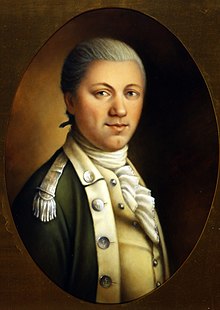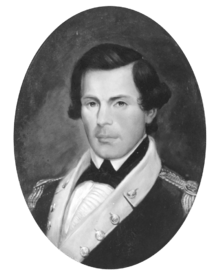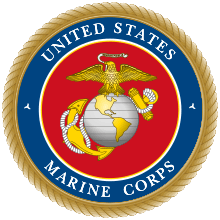Samuel Nicholas
Samuel Nicholas (1744 – 27 August 1790) was the first officer commissioned in the United States Continental Marines (predecessor to the United States Marine Corps) and by tradition is considered to be the first Commandant of the Marine Corps.
Samuel Nicholas | |
|---|---|
 Portrait by Maj. Donna J. Neary, USMCR, 1989. Hangs in the Marine Corps Commandant’s house.[1] | |
| Born | 1744 Philadelphia, Pennsylvania |
| Died | 27 August 1790 (aged 45–46) Philadelphia, Pennsylvania |
| Place of burial | |
| Allegiance | |
| Service/ | Continental Marines United States Marine Corps |
| Years of service | 1775–1783 |
| Rank | Captain |
| Commands held | Commandant of the Marine Corps |
| Battles/wars |
|
Early life
Nicholas was born in Philadelphia, Pennsylvania in 1744, the youngest of three, to Anthony and Mary (Shute Cowman) Nicholas. His father was a blacksmith. and his uncle was Attwood Shute, the Mayor of Philadelphia (1756–1758). Nicholas was educated at the College of Philadelphia (now the University of Pennsylvania), and was a Freemason who belonged to a Masonic Lodge that met at Tun Tavern.
Military service

On 28 November 1775, Nicholas was commissioned a "Captain of Marines" by the Second Continental Congress,[2] which was the first commission issued in the Continental Naval Service.[3][2][4] 18 days after the Continental Congress resolved on 10 November 1775, "That two battalions of Marines be raised consisting of one Colonel, two Lieutenant-Colonels, two Majors, and other officers, as usual in other regiments; that they consist of an equal number of Privates with other battalions; that particular care be taken that no persons be appointed to offices, or enlisted into said battalions, but such as are good seamen, or so acquainted with maritime affairs as to be able to serve by sea when required; that they be enlisted and commissioned to serve for and during the present war with Great Britain and the Colonies, unless dismissed by order of Congress; that they be distinguished by the names of the First and Second Battalion of Marines."[5]
Captain Nicholas no sooner received official confirmation of his appointment to office than he established recruiting headquarters in Philadelphia. By January 1776, having recruited a sufficient number of Marines for the vessels that comprised the Continental Navy in the waters of Philadelphia, Capt. Nicholas assumed command of the Marine Detachment on board the Alfred. With Commodore Esek Hopkins in command, the Alfred set sail from Philadelphia on the morning of 4 January 1776. The following month witnessed the baptismal fire of the Marines.
Battle of Nassau
Lord Dunmore, the royal governor of Virginia], had collected a store of arms and provisions at New Providence, in the Bahamas. Dunmore's forces had done a great deal of injury along the Colonial coast, especially the shore of Virginia. Commodore Hopkins had been ordered to proceed to Abaco in the Bahamas, and from there to operate against the forces of Lord Dunmore. Commodore Hopkins decided to make an attack on New Providence, capture the enemy's stores, and destroy his supplies. Capt Nicholas was placed in command of the landing party of 234 Marines.[6] This attack,the first successful landing engaged in by Continental Marines, saw the capture of Nassau on 3 March 1776 without a fight.
On 6 April 1776, the Marines participated in the first naval battle between an American squadron and a British warship, when HMS Glasgow came upon the squadron.
Promoted to Major
On 25 June 1776, Congress placed Nicholas "at the head of the Marines with the rank of Major". Accordingly, Commodore Hopkins was advised to send Major Nicholas to Philadelphia, with dispatches for the Continental Congress. With notification of his promotion he was ordered to report to the Marine Committee. The Committee detached him from the Alfred and ordered him to remain in the city, "to discipline four companies of Marines and prepare them for service as Marine guards for the frigates on the stocks". Having recruited and thoroughly organised the companies, he requested arms and equipment for them.
1776–1779
In December 1776, Major Nicholas wrote to Congress: "The enemy having overrun the Jerseys, and our army being greatly reduced, I was ordered to march with three of the companies to be under the command of His Excellency, the Commander-in-Chief." This was the first example of a battalion of Marines about to serve as an actual fighting unit under the direct command of Army authority. The Marines did not, however, engage in the attack on Trenton, on 26 December 1776, which followed General George Washington's crossing of the Delaware River. They were attached to General John Cadwalader's division, which was ordered to cross the Delaware to Burlington, New Jersey, south of Trenton, in concert with Washington's crossing to the north on the night of 25 December 1776, but was turned back due to ice floes on the river.
After the first Battle of Trenton, the battalion of Marines under the command of Maj. Nicholas participated in a battle with a detachment of Cornwallis's main army at Princeton, New Jersey. During the ensuing months, Nicholas's battalion served both as infantry and artillery, participating in several skirmishes.
Following the British evacuation of Philadelphia in June 1778, the Marine Barracks were reestablished and recruiting resumed. From then until the close of the war, Nicholas's duties at Philadelphia were similar to those of later Commandants. Moreover, he was actively in charge of recruiting, and at times acted as Muster Master of the Navy.
On 20 November 1779, Nicholas wrote Congress tp request he be put in charge of the Marine Detachment aboard the 74-gun ship of the line America, then being constructed in Portsmouth, New Hampshire. However, Congress was firm in its intention that Nicholas remain in Philadelphia. Upon her completion, the America was presented to France as a gift.
Return to civilian life
After the Navy and Continental Marines were disbanded following the end of the American Revolutionary War in 1783, Nicholas returned to civilian life and became an original member of the Pennsylvania Society of the Cincinnati.
He died on 27 August 1790, in Philadelphia during an epidemic of yellow fever and is buried in the Friends Graveyard at Arch Street Friends Meeting House.
Legacy
Three ships in the United States Navy have been named the USS Nicholas in his honor.
On 10 November of each year, the date celebrated as the Marine Corps' birthday, Nicholas's grave in the Arch Street Friends Meeting graveyard in Philadelphia is marked with a wreath at dawn by a detachment of Marines. [7]
A British 6-pounder cannon, captured by Major Nicholas' Marines at Nassau, is on display at Fort Phoenix in Fairhaven, Massachusetts.
See also
- History of the United States Marine Corps
- Commandant of the Marine Corps
- List of Historically Important U.S. Marines
References
- Upton, Lt. Col. Stewart. "First Marine Corps Leader All About Institution, Not Self". www.imef.marines.mil. U.S. Marine Corps. Retrieved 29 July 2020.
- Destroyer History Foundation biography.
- Marine Corps biography.
- "Marine Captain Samuel Nicholas commission". Archived from the original on 31 December 2006. Retrieved 3 March 2007. Photograph of commission, signed by John Hancock.
- Continental Congress (10 November 1775). "Resolution Establishing the Continental Marines". Historical Documents, Orders and Speeches. History Division, United States Marine Corps. Archived from the original on 6 August 2007. Retrieved 3 March 2007.
- http://www.marines.com/history-heritage/timeline
- Mucha, Peter (11 November 2008). "Ceremony honors Marine Corps founder". Philadelphia Inquirer.
Further reading
- "Major Samuel Nicolas, Continental Marines". Who's Who in Marine Corps History. History Division, United States Marine Corps.
- "Major Samuel Nicolas, Continental Marines ca. 1744–1790". Destroyer History Foundation. Archived from the original on 10 February 2007. Retrieved 3 March 2007.
- Millett, Allan Reed; Shulimson, Jack, eds. (2004). Commandants of the Marine Corps. Annapolis, Maryland: Naval Institute Press. pp. 17–26. ISBN 978-0-87021-012-9.
External links
- Louis Estell Fagan (November 1933). "Samuel Nicholas, First Officer of American Marines". Marine Corps Gazette. XVIII (3). Archived from the original on 1 January 2007. Retrieved 3 March 2007.
- Samuel Nicholas at Find a Grave
| Military offices | ||
|---|---|---|
| Preceded by New creation |
Commandant of the United States Marine Corps 1775–1783 |
Succeeded by Lt.Col. William Ward Burrows I (in 1798) |
